

Roll players: A look back at the era when cars were fired up with roller starters
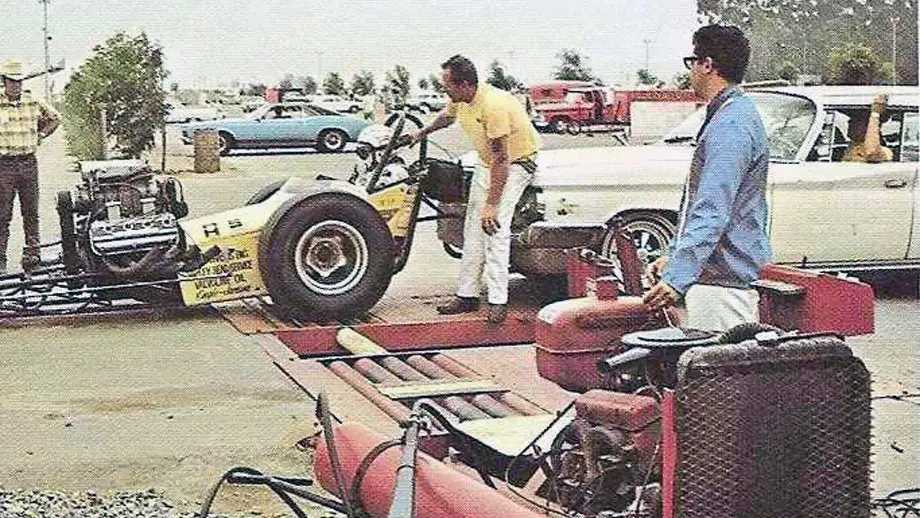

Before NHRA mandated the use of remote starters for Top Fuelers for the 1975 season, the time-honored tradition of starting a Top Fueler was the good-old push start.
In much the same way that you can jump-start your dead-battery, manual transmission-equipped street car, it’s a simple matter of getting the car up to speed –- with buddy power or gravity power -- and dropping the clutch with the transmission in gear when you reach 5-10 mph. Top Fuelers were started pretty much the same way. Pushed by support vehicles down the strip or the return/fire-up road from the finish line to the starting line, it required a few more steps and a little more speed but basically accomplished the same goal.
The problem with this procedure was that it sent a pair of fully-lit nitro dragsters rolling to the crowded and compact starting-line area and it only took a stuck throttle, balky clutch, or fading brakes to create a potential catastrophe.
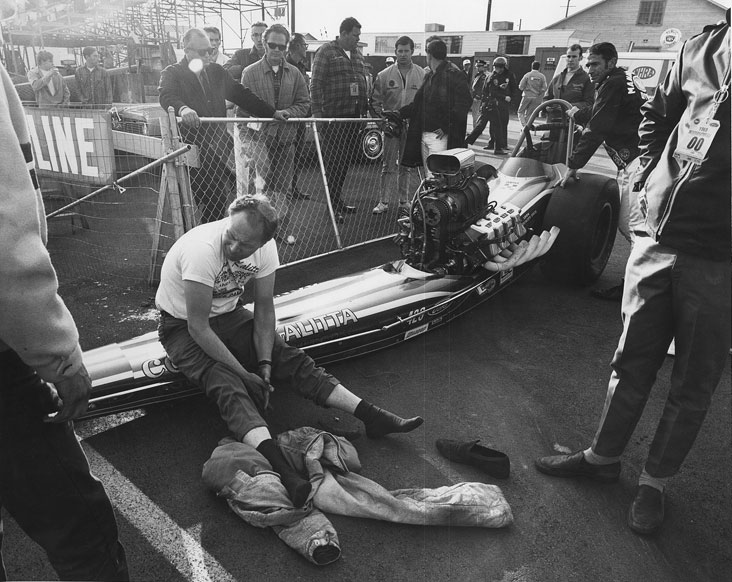
Just ask Connie Kalitta, shown sitting forlornly on his bent-up dragster after failing to successfully navigate the turn after a push start at the 1969 Winternationals, Other than some mangled pipe and Kalitta's hurt feelings, no other injuries were sustained.
The other problem was that push starts really slowed down the show. At most tracks, even those with roller starters on the return/fire-up road, the cars would have to make a U-turn at the starting line, which often turned into a 20-point turn before a car was pointed the right way down the strip, as you can see in the Steve Reyes photo below.
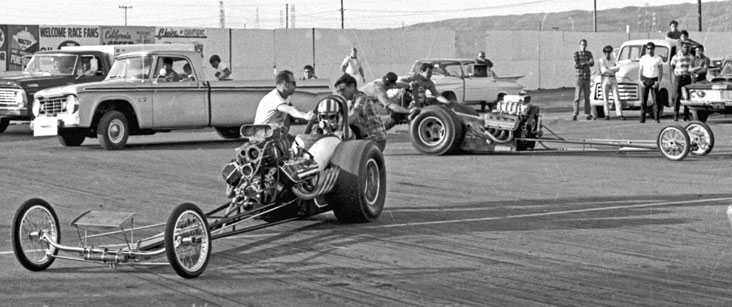
“Because of the lengthy wheelbases on the later-front motor cars, pushing them back and forth to get the car lined up was very time-consuming,” remembers NHRA national event-winning Top Fuel racer Carl Olson. “Also, by the time you made the burnout and backed up, a lot of times the engines would overheat. It just took a long time to get everyone ready.”
That problem was even worse for tracks that weren’t set up with hot-car pits at the top end to push down from or those that didn’t have return roads. At those tracks, the cars were pushed down the track from the starting line to the finish without being lit, then made a U-turn past the finish line, then fired up on the way back up the track.
And from all these struggles was born the roller starter, the subject of today’s history lesson. They only existed for a short time -– from 1964 through 1974 -– but played an interesting role in the sport’s history.
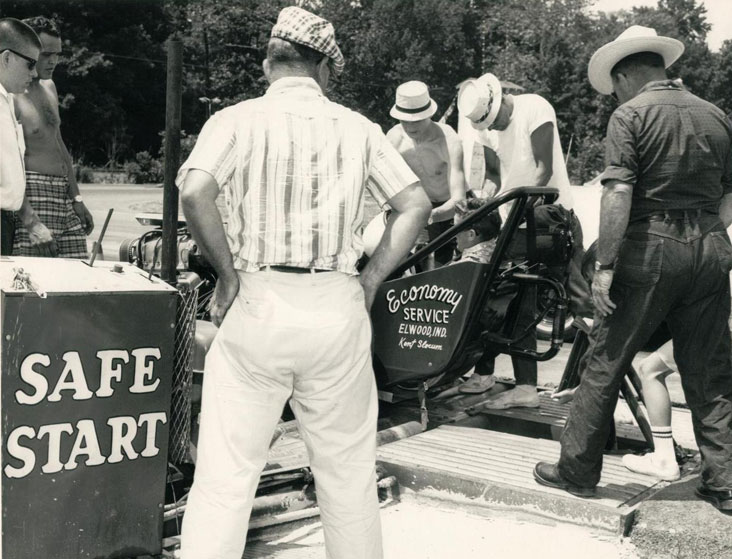

Bunker Hill Drag Strip in Bunker Hill, Ind, did not have hot-car staging and track owner Jim Hullinger figured there had to be a better way of getting the cars lit and staged. He was an industrious guy, having previously developed his own track lighting (using car headlights) and had built his own scoreboards, and he is generally credited with developing the first roller starters for his track in 1964,. He placed them in the staging lanes so that a driver could fire his car right there and then drive into right into the burnout box.
Hullinger continued to tinker with his designs, which he then sold under the Safe-Start brand name, and which were deployed at as many as three dozen tracks, primarily those in the Midwest, including Indy and Bowling Green. You could buy them for one or two cars: $3,377 and $5,495, respectively. All were equipped with 283-cid Chevy engines and transmissions, though you could buy extras of each. Hullinger also made models that were wider to support sprint cars, which also are generally push-started.
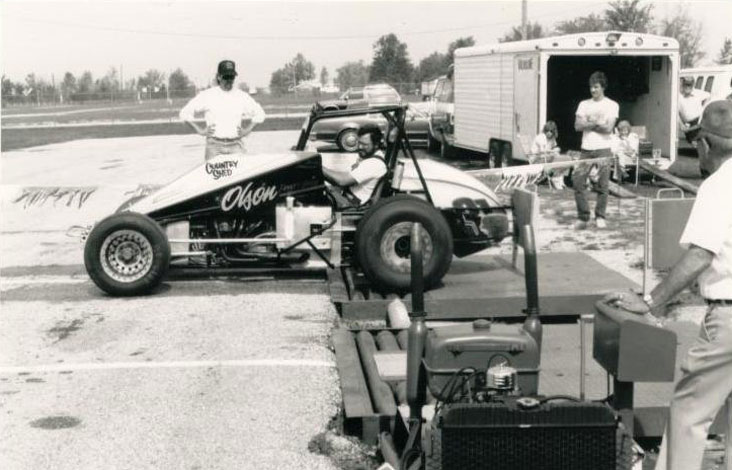
This photo is from a demonstration that Hullinger staged for USAC to show how his units would work with a sprint car.
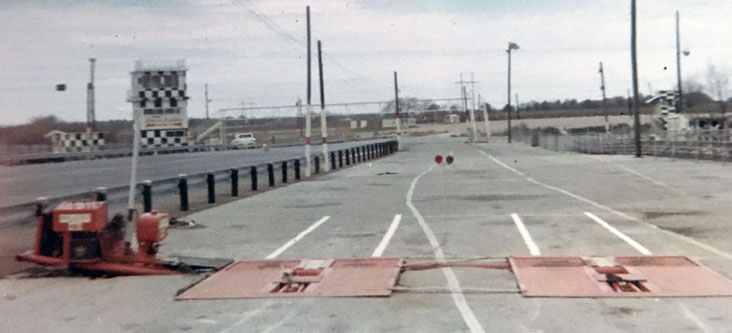
Here’s a great shot of some side-by-side rollers embedded on the return road at Green Valley Race City in Texas.

While some tracks embedded their roller starters in the ground so that a driver could drive right on and off, there also were some tracks that preferred their units to be more portable and moved around the facility. They simply added on- and off-ramps to facilitate the procedure.
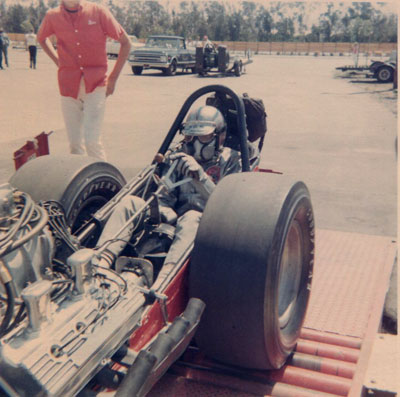
The problem with cars firing up by push start was not unique to the actual racing. Believe it or not, that problem was even worse in the pits, where teams would sometimes try to test-fire their repaired engines by push-starting them between the rows of trailers. You could see how that could get ugly really quickly.
"Having roller starters in the pit made it a lot safer," said legendary car owner Roland Leong. "There were a lot fewer hassles trying to start your engine in the pits. Cars were everywhere, and trying to push start it in the pits was nearly impossible. They were definitely a blessing."
Tracks like Orange County Int’l Raceway had roller starters only in the pits and only for the test-fire purpose, not to have them for an actual run. You can see a bunch of OCIR photos further down in this article as kindly provided to me by Rev. Jim Jack of Racers For Christ, who was nice enough to send me an entire photo album filled with hundreds of shots like the one at the right of Leland Kolb.
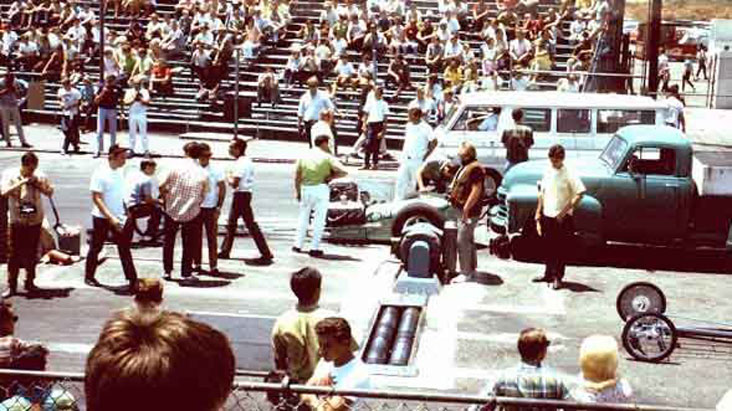
While most roller starters were either in the pits or on the return road, fabled Lions Drag Strip in Southern California had what was one of the few starting-line-based roller starters, positioned roughly halfway between the starting line and Lions’ trademark track-spanning tower. They were installed by track operator C.J. “Pappy” Hart after Walt Stevens took a wild ride in the Childs & Albert Addict after its B&Torkmaster transmission reportedly wouldn’t release and the throttle got stuck at a high idle. He slalomed through the staging lanes before crashing to a halt.
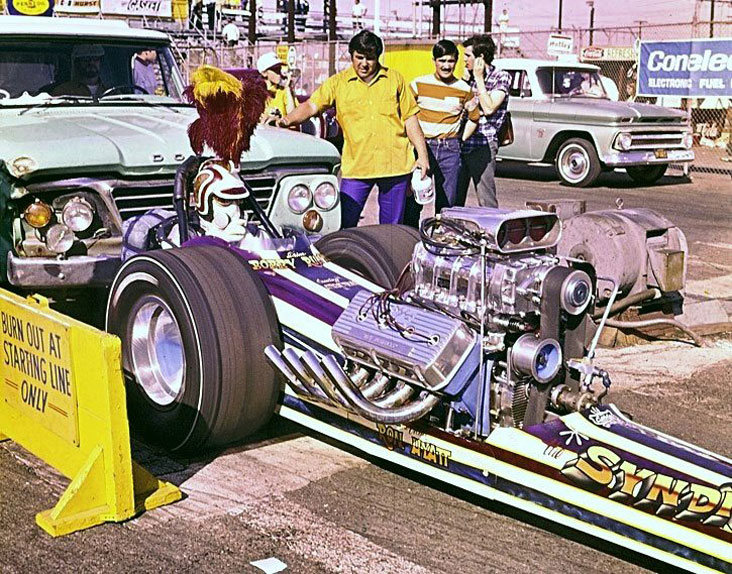
Also, unlike other tracks whose rollers were powered by an automotive engine/transmission coupled to the starters, Lions’ rollers ran off of giant electric motor. The first ones that were installed worked well until they choked while trying to start the fabled Freight Train twin-engine gas dragster one night, so a bigger motor was installed.
“I loved the roller starters at Lions,” Olson continued. “I distinctly remember the whirr of the electric motor on the rollers getting up to speed.”
Longtime Lions starter Larry Sutton, who also drove dragsters there -- that's him pictured above in a Jr. Fuel dragster -- also fondly remembered the roller starters, and for more than one reason.
“I remember that when you started the rollers, the track lights would dim, and that was even with 440[-volt] power,” he recalled with a laugh. “They drew a lot of power, but they saved a lot of people and made the show go a lot faster.”
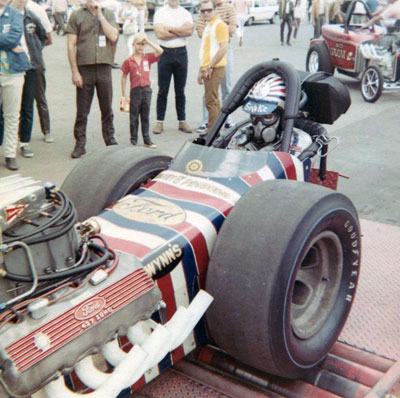
“They were great,” agreed Don Prudhomme of roller starters in general. That's "Snake" at right in the Shelby Super Snake about to get fired up at OCIR. “They fit a period of time and it made things a lot simpler, especially in the pits at places like Indy and Orange County [Int’l Raceway]. For a while there they really elevated the sport.”
Regardless of where the rollers were located, the procedure was pretty much the same. A car would be pushed onto the roller and locked in place either by the push vehicle, by a gate that would close behind the car, or held by hand.
With the racecar's clutch pedal pushed in and the driveline disengaged, the roller operator would fire up the drive engine, shift it into gear, and start the big drums spinning. Typically there were four drums –- two spinning clockwise, two counter-clockwise -– and once they got going, the driver would wait for the oil pressure to get to normal, then engage the clutch, and hit the magneto switch to bring the engine to life.
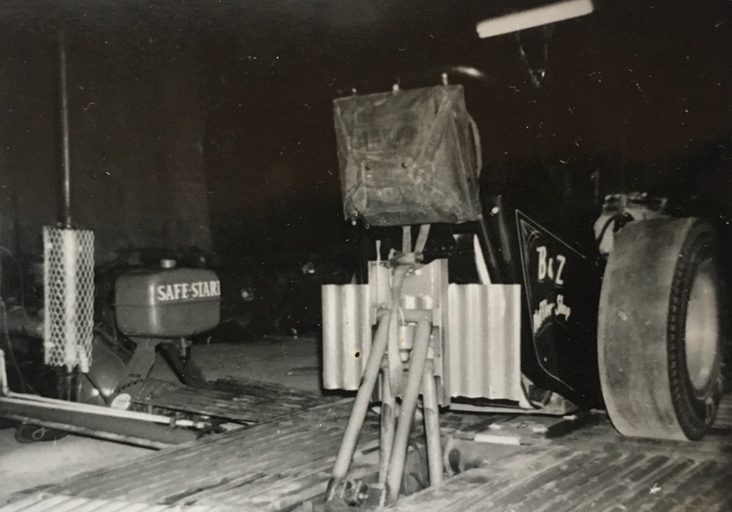
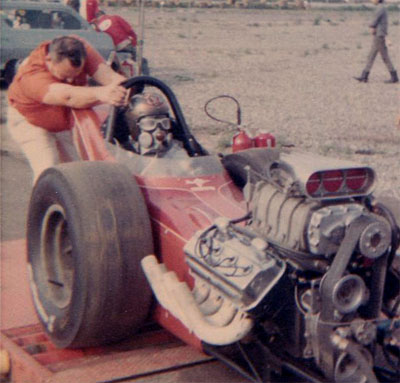
Initially, the Safe Start system had a hydraulic ramp that would lift up behind the car to keep it in place, but they went away pretty quickly. Every track had its procedures, but often it was a guy just holding onto the rollbar or holding the front tires, which also was fraught with danger.
“I remember one race where Warren & Coburn hydraulicked the engine on the rollers and blew the front of the cylinder head and block off and hit Bob Hightower, who was holding the front tires," Sutton recalled. "His arm got cut open for like 90 stitches. It was bad.”
Jay Hullinger also remembers well the problems that some drivers had with his father’s new invention. “If the driver rapped the throttle and ran the tires faster than the rollers were going, he could shoot off of the platform. Of course, the first thing a driver would do was grab the brake handle and that would stop the tires, and then the rollers would slam him back against the gate. It was just amazing that there we so many racers who couldn’t figure out the basis of it.”
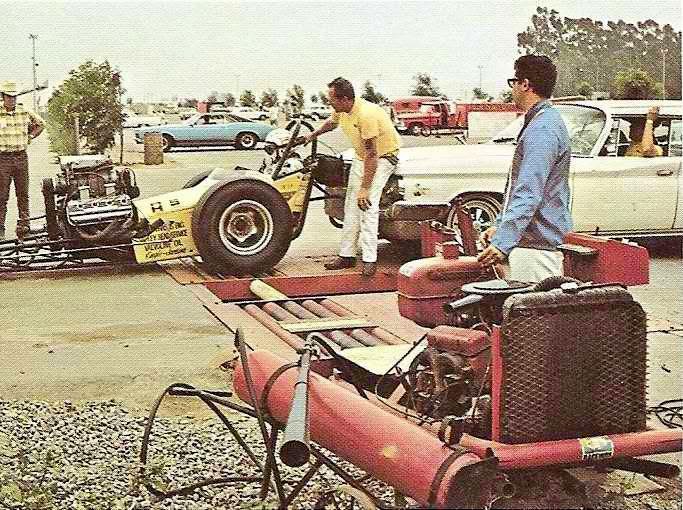
According to my good pal and fellow drag racing history nut Bret Kepner, the skills required to pull this off successfully also relied on the guy running the rollers.
“The roller operator really needed to know their [stuff],” said Kepner, who for a few years managed St. Louis Int’l Raceway. “We had a guy named Jim Lockaby who was the only guy allowed to go near those things when there was a car on it. You had to know when to hit the brakes on the rollers to allow the car to come off. If you hit the brake before the driver was ready for it, the car would [hook up and] do a wheelstand off the rollers. If he was too slow the driver could get confused. It was actually a very intricate starting procedure.”
Here are some photos from the previously-mentioned archives of Jim Jack, all shot at OCIR's pit rollers.
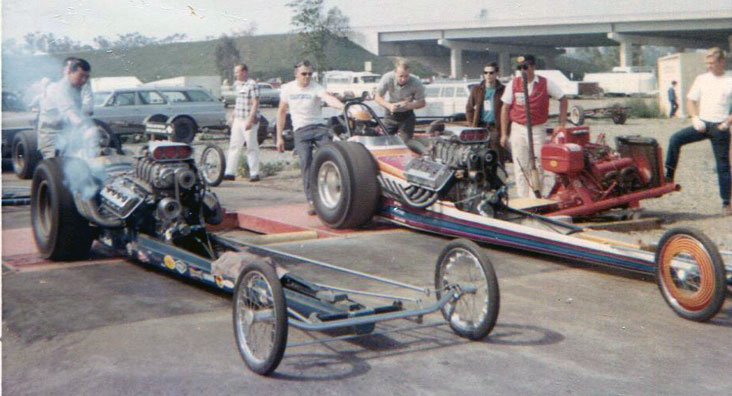
Stan Shiroma and Dick Kalivoda in the Saturn V fire up together.
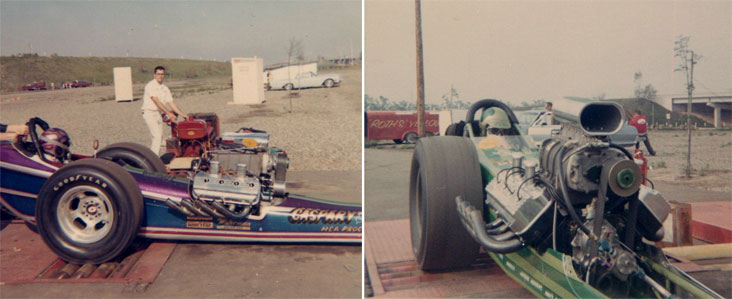
(Left) Jeep Hampshire in the Caspary & Hampshire car; (right) the late, great Jim Mulligan in the Beebe & Mulligan entry.
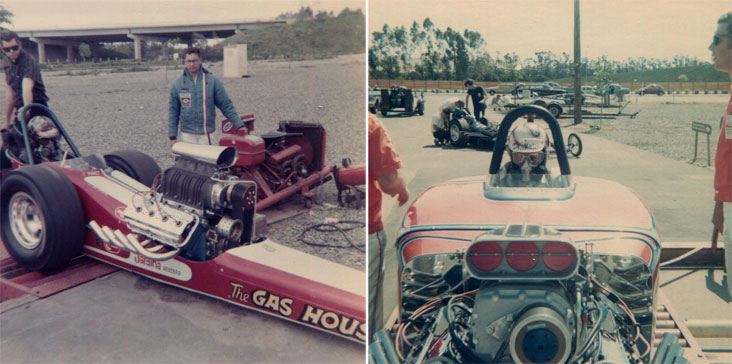
It wasn't just Top Fuelers on the rollers: (left) Walt Rhoades and the Gas House Gang Top Gas dragster and (right) Tony DiMatteo in the Matteo Bros. Fuel Altered.
And a few more random roller starter images gathered from a variety of places and sources:
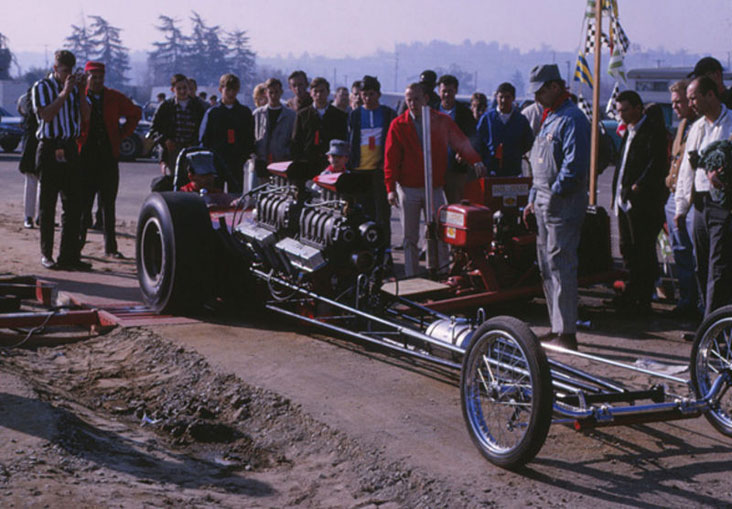
The fabled Freight Tran Top Gas dragster, which broke the first electric rollers at Lions.

Roger Clayton in Don Fox's dragster on the rollers in Dallas.
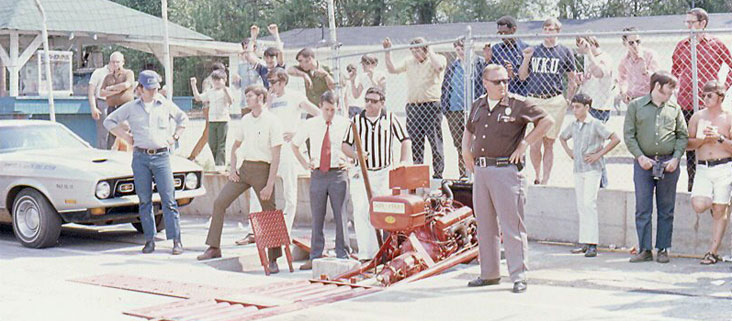
The roller starters at Beech Bend Raceway Park in Bowling Green, Ky., were located close to the crossover bridge.
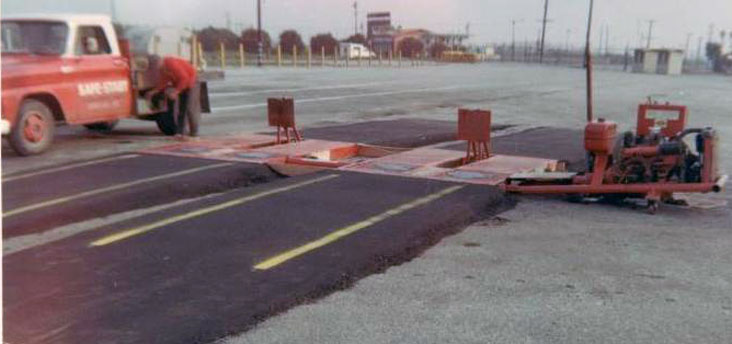
Roller starters in the pits at La Place Dragway in Louisiana.
Even though remote starters were not required by NHRA until 1975, a number of teams had begun shunning the rollers after buying their own starters for the sake of convenience. The team of Mike Kuhl and Olson were among them.
“Mike and I had a starter for our car as early as 1972 when we went on tour, and we’d use it to warm up in the pits,” he said. “At that time, NHRA wouldn't actually let you use it at national events before a qualifying or eliminations run; you had to push start because that kind of evened the score for everybody. I guess, logistically, it makes sense for everybody to use the same system, but a lot of teams were like us and they had an electric starter, so it no big deal when NHRA did away with the push start."

The famed electric rollers remained in action at Lions until the day the music died, Dec. 2, 1972, at the track’s wild and wooly Last Drag Race, which Olson won. The cars were rear-engined by then but still used the roller starters and, according to Olson, if it weren’t for the starting-line rollers, there might not have been a last Top Fuel race at The Last Drag Race.
“I remember sitting on those rollers getting ready to run Jeb Allen in the final,” he remembered. “There was such a crowd on the starting line, I wasn't sure I'd be able to actually get up there and make a burnout and stage. It was just pandemonium. Thank God we were using the rollers and not trying to push start because it probably would have been impossible at that event because the fans had climbed out of the grandstands and standing beside the track and on the return road. It was crazy, it was absolutely nuts”
And, as much as remote starters and roller starters enhanced the sport, Olson still holds a sweet spot for those good ol’ push starts.
“I have to say there was a part of me that missed the pushdowns," he said. "They were a big part of the show both for the spectators and the racers. I remember getting ready to race, pushing down the fire up road, people waving at you and screaming and jumping up and down. It was a fun deal but it just was impractical after a period of time.”
![]()
Olson also put me in touch with Mike Roth, who owns a collection of famous front-engines dragsters and is in the process of restoring a set of Bunker Hill’s old roller starters.
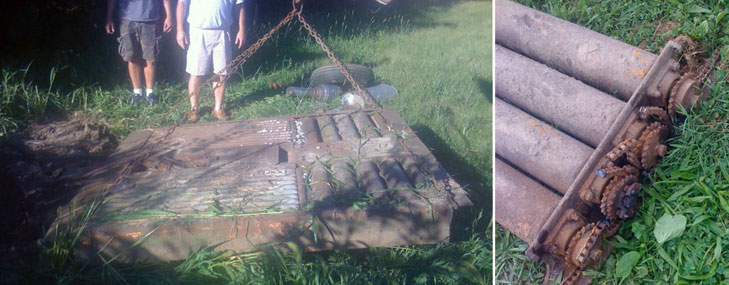
They were able to unearth the original single-roller bed from its long resting place at the Hullinger home. As you can see in the photo above it took a lot of work and the chains that connected the rollers were rusted and broken.
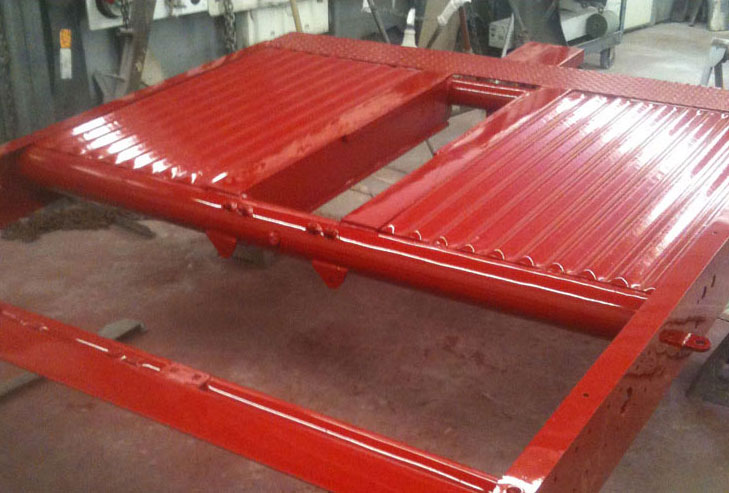
The restored bed, just waiting for the roller barrels to be installed.
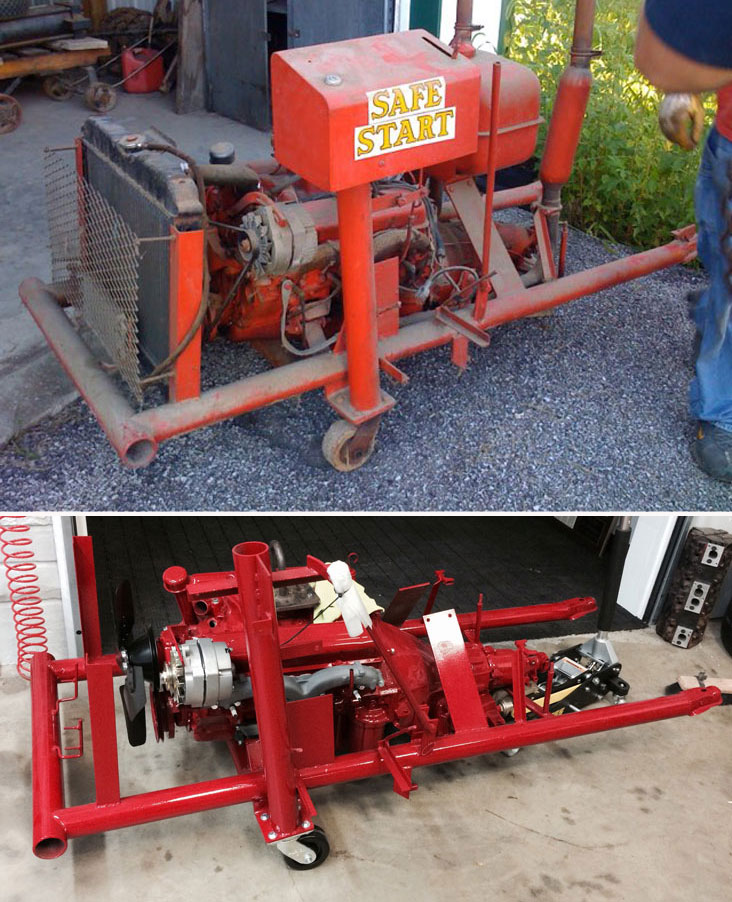
The starter cart also was in rough shape -– the oil pan had rusted off –- and they found a second cart (one used in Indy), but that needed a new engine, so he got one. Looking good! Roth hopes to be able to bring them to nostalgia events or displays to expose them to new and old fans eager to get another taste of drag racing nostalgia.
OK, gang, thanks for rolling along and reading up on this interesting part of the sport's history. I hope you enjoyed it.
Stay safe out there,
Phil Burgess can be reached at pburgess@nhra.com
Hundreds of more articles like this can be found in the DRAGSTER INSIDER COLUMN ARCHIVE



















































